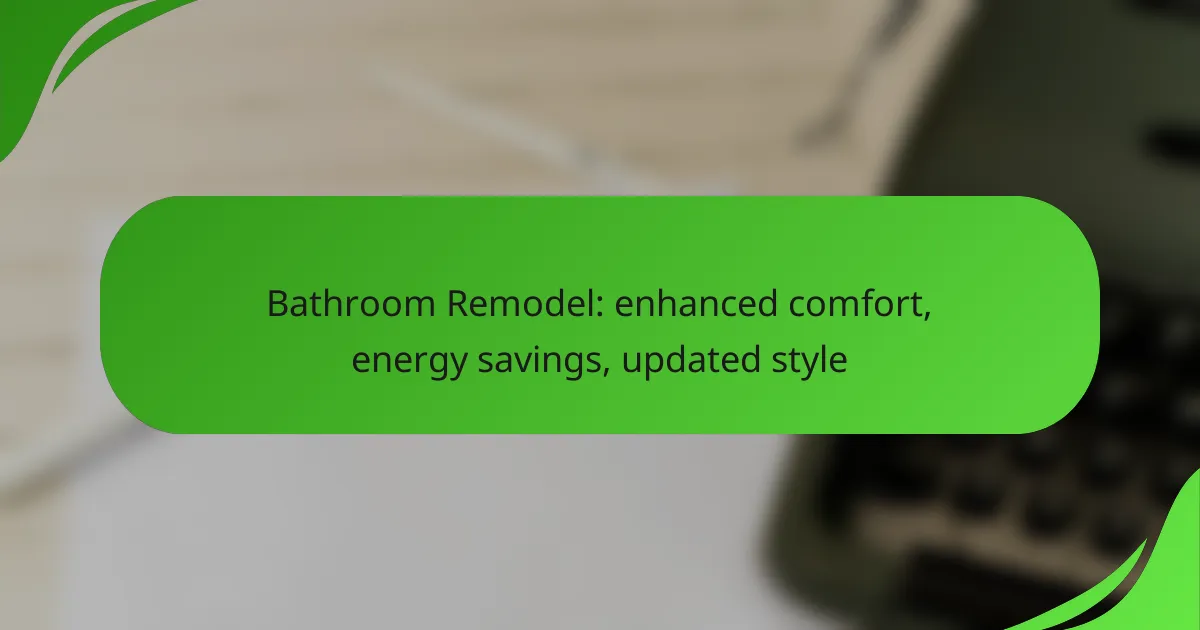A bathroom remodel offers an excellent opportunity to enhance comfort, improve energy efficiency, and update the overall style of your space. By optimizing layout, incorporating modern fixtures, and utilizing better lighting, you can create a more inviting and functional environment. Additionally, energy-efficient upgrades not only lower utility bills but also promote sustainability, making your bathroom both stylish and eco-friendly.

How can a bathroom remodel enhance comfort in homes?
A bathroom remodel can significantly enhance comfort by optimizing space, improving usability, and creating a more inviting atmosphere. Key upgrades like layout changes, modern fixtures, and better lighting contribute to a relaxing and functional environment.
Increased space with layout changes
Reconfiguring the layout of your bathroom can create a more spacious feel, even in smaller areas. Consider moving fixtures or removing unnecessary walls to open up the space, allowing for easier movement and accessibility.
When planning layout changes, think about the flow of the room. A common approach is to place the shower or tub at the far end, with the toilet and sink closer to the entrance, which can help maximize space and functionality.
Upgraded fixtures for better usability
Modern fixtures can greatly enhance usability, making daily routines more efficient. For example, installing a comfort-height toilet can make it easier for users of all ages to sit and stand.
Consider adding features like touchless faucets and adjustable showerheads, which not only improve convenience but also promote better hygiene. These upgrades can be particularly beneficial for families with children or elderly members.
Heated flooring for warmth
Heated flooring is a luxurious upgrade that adds warmth and comfort, especially during colder months. This feature can be installed under tile or stone surfaces, providing consistent heat that makes stepping out of the shower or bath much more pleasant.
When considering heated flooring, look for systems that offer programmable thermostats, allowing you to set the temperature according to your schedule. This can lead to energy savings while ensuring a cozy environment.
Improved lighting for ambiance
Upgrading lighting can transform the mood of your bathroom, making it feel more inviting. Layered lighting, which combines ambient, task, and accent lighting, can enhance both functionality and aesthetics.
Consider installing dimmable lights or fixtures with adjustable brightness to create a relaxing atmosphere during baths or a bright environment for grooming tasks. Natural light is also beneficial, so if possible, incorporate windows or skylights to bring in daylight.

What energy savings can be achieved through a bathroom remodel?
A bathroom remodel can lead to significant energy savings by incorporating modern fixtures and materials that enhance efficiency. Upgrading to energy-efficient appliances and fixtures not only reduces utility bills but also contributes to environmental sustainability.
Low-flow fixtures for water conservation
Installing low-flow fixtures, such as showerheads and faucets, can drastically reduce water consumption without sacrificing performance. These fixtures typically use less than 2.5 gallons per minute, compared to older models that may use over 5 gallons.
Consider replacing toilets with high-efficiency models that use around 1.28 gallons per flush, which can save a household thousands of gallons of water annually. Look for fixtures that meet WaterSense standards for optimal efficiency.
Energy-efficient lighting options
Switching to energy-efficient lighting, such as LED bulbs, can significantly lower electricity costs in your bathroom. LEDs use about 75% less energy than traditional incandescent bulbs and last much longer, reducing replacement frequency.
When remodeling, consider installing dimmable LED fixtures to enhance ambiance while saving energy. Additionally, incorporating natural light through windows or skylights can further decrease reliance on artificial lighting.
Insulation improvements for temperature control
Improving insulation in your bathroom can help maintain a comfortable temperature and reduce heating and cooling costs. Insulating walls, ceilings, and floors can prevent heat loss in winter and keep the space cooler in summer.
Use materials that meet local building codes and consider adding insulation to pipes to prevent heat loss. Properly sealed windows and doors also contribute to energy efficiency, ensuring that your remodeled bathroom remains comfortable year-round.

What updated styles are popular in bathroom remodels?
Popular updated styles in bathroom remodels focus on creating a balance between aesthetics, functionality, and sustainability. Homeowners are increasingly drawn to designs that enhance comfort while also offering energy savings and modern flair.
Modern minimalist designs
Modern minimalist designs emphasize simplicity and functionality, often featuring clean lines and a neutral color palette. This style typically incorporates open spaces, allowing for a more airy feel, and utilizes sleek fixtures that blend seamlessly into the overall design.
To achieve a modern minimalist bathroom, consider using wall-mounted sinks and toilets, large-format tiles, and frameless glass shower enclosures. These elements not only save space but also create a streamlined look that is easy to maintain.
Vintage and retro aesthetics
Vintage and retro aesthetics bring a sense of nostalgia and character to bathroom spaces. This style often includes classic fixtures, patterned tiles, and bold colors reminiscent of earlier design eras, creating a warm and inviting atmosphere.
Incorporating vintage elements can be as simple as adding a clawfoot tub or using subway tiles in unique arrangements. Mixing old and new pieces, like pairing a vintage vanity with modern lighting, can enhance the overall appeal while maintaining functionality.
Eco-friendly materials and finishes
Eco-friendly materials and finishes are increasingly popular in bathroom remodels, focusing on sustainability without sacrificing style. Options like reclaimed wood, recycled glass, and low-VOC paints contribute to a healthier environment and often reduce energy costs.
When selecting eco-friendly materials, look for certifications such as FSC for wood products or Energy Star ratings for fixtures. Not only do these choices support environmental responsibility, but they can also improve indoor air quality and lower utility bills over time.

What are the costs associated with a bathroom remodel in the United States?
The costs of a bathroom remodel in the United States can vary significantly based on factors such as size, materials, and labor. On average, homeowners can expect to spend anywhere from $10,000 to $30,000, depending on the extent of the renovation and the quality of finishes chosen.
Average cost per square foot
The average cost per square foot for a bathroom remodel typically ranges from $100 to $250. Smaller bathrooms may fall on the lower end of this spectrum, while larger, more luxurious spaces can push costs higher. It’s essential to consider the layout and existing plumbing when calculating square footage costs.
For example, a 50-square-foot bathroom remodel could cost between $5,000 and $12,500, depending on the choices made. Homeowners should budget accordingly and account for any unexpected expenses that may arise during the renovation process.
Cost breakdown by materials
Material costs can significantly impact the overall budget of a bathroom remodel. Common materials include tiles, countertops, fixtures, and cabinetry, each with a wide price range. For instance, ceramic tiles may cost around $1 to $15 per square foot, while natural stone tiles can range from $5 to $30 per square foot.
When selecting materials, consider both aesthetics and durability. Investing in higher-quality materials may lead to longer-lasting results, reducing the need for future repairs or replacements. Create a prioritized list of materials to help manage costs effectively.
Labor costs for professional services
Labor costs for professional services in a bathroom remodel can account for a significant portion of the budget, typically ranging from 20% to 35% of the total project cost. Hiring licensed contractors, plumbers, and electricians ensures that the work meets local codes and standards.
On average, labor rates can vary by region, with hourly rates for skilled tradespeople ranging from $50 to $150. It’s advisable to obtain multiple quotes and check references to ensure competitive pricing and quality workmanship. Always factor in potential additional costs for unexpected issues that may arise during the remodel.

What factors should be considered before starting a bathroom remodel?
Before starting a bathroom remodel, it’s essential to consider the existing infrastructure, budget constraints, and the selection of a qualified contractor. These factors will significantly influence the project’s success and overall satisfaction with the results.
Assessing current plumbing and electrical systems
Evaluating your existing plumbing and electrical systems is crucial for a successful remodel. Check for any outdated pipes or wiring that may need replacement to avoid future issues. Consider the layout of your bathroom and how it may affect the placement of fixtures and outlets.
Older homes may require upgrades to meet current building codes, which can impact your budget and timeline. Hiring a professional to inspect these systems can provide insights into necessary improvements and help you plan accordingly.
Setting a realistic budget
Establishing a realistic budget is vital for a bathroom remodel. Consider all potential costs, including materials, labor, permits, and unexpected expenses. A general guideline is to allocate around 10-20% of your home’s value for a comprehensive bathroom renovation.
To avoid overspending, create a prioritized list of must-haves versus nice-to-haves. This approach allows you to make informed decisions and adjustments as needed throughout the project.
Choosing the right contractor
Selecting a qualified contractor can make or break your bathroom remodel. Look for professionals with experience in bathroom renovations and positive customer reviews. Obtain multiple quotes to compare pricing and services offered.
Check for proper licensing and insurance to ensure you are protected during the project. Establish clear communication and expectations upfront to foster a collaborative working relationship and minimize misunderstandings.

How can homeowners maximize the value of their bathroom remodel?
Homeowners can maximize the value of their bathroom remodel by focusing on features that enhance comfort, improve energy efficiency, and update the overall style. Prioritizing high-demand elements and ensuring quality craftsmanship can significantly increase both functionality and resale value.
Choosing high-demand features
Selecting high-demand features is crucial for maximizing the value of a bathroom remodel. Popular choices include energy-efficient fixtures, modern vanities, and spacious showers. Homeowners should consider trends such as smart technology, which can add convenience and appeal.
Incorporating features like heated floors or water-saving toilets can enhance comfort while also appealing to eco-conscious buyers. Research local market preferences to identify which features are most sought after in your area.
Focusing on quality over quantity
Investing in quality materials and workmanship is essential for a successful bathroom remodel. High-quality tiles, fixtures, and cabinetry not only look better but also last longer, reducing the need for future repairs. Aim for a cohesive design that emphasizes durability and style rather than cramming in too many elements.
Consider hiring experienced professionals for installation to ensure that the work meets industry standards. This can prevent costly mistakes and ensure that the remodel adds real value to the home.








